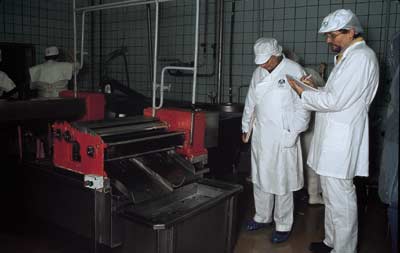Danish - Lithuanian Environmental Co-operation 1991-2000
Chapter 11
Improving the environment through cleaner technology
Projects described:
Introduction
of Cleaner Technology in Lithuanian Slaughterhouses
In relation to industrial pollution control, Danish support has primarily been implemented through projects targeted at introduction of Cleaner Technologies in Lithuanian industries and projects in the electroplating industry, the leather industry and in slaughterhouses.
Due to the decline and modernisation of industrial activities in Lithuania, pollution load from the industry has diminished since the regaining of independence. It is anticipated that pollution load from industries will continue to drop since the heavily polluting enterprises with manufacturing lines based on resource consuming soviet-type process lines will not be able to compete in a open market economy.
In relation to abatement of industrial pollution control, Danish support has primarily been implemented through projects targeted at introduction of Cleaner Technologies in Lithuanian industries and projects in the electroplating industry, the leather industry and in slaughterhouses.
Presently, the Danish Environmental Protection Agency is preparing a number of projects aiming to introduce cleaner technologies and energy saving in a number of the largest resource consuming Lithuanian enterprises in co-operation with the Danish Energy Agency and the Lithuanian counterparts.
These projects are implemented as part of the Danish assistance that was committed when Lithuania made its political decision to close down the Nuclear Power Plant at Ignalina, not the least because of the Lithuanian industries' concern of that the expected higher energy prices would impair their competitiveness in an open market.
A win-win situation
As is the case with other projects in relation to the use cleaner technologies, this effort will bring about a win-win situation where resource consumption and pollution will decline at the same time as production efficiency and competitiveness for the involved industries will increase.
Environmental management and auditing is a target area of the cross sector programme implemented by the Danish Ministry of Trade and Industry and projects have been implemented in the textile, the food, the paint and lacquer industry, as well as in the electronic and the metal processing industries.
Introduction of Cleaner Technology in Lithuanian Slaughterhouses
Investments in cleaner technology are expected to lead to substantial environmental improvements at the slaughterhouses in Lithuania. Except from water and electricity savings, the improvements also lead to the reduction of pollution and training which included a study tour to slaughterhouses in Denmark.
A pre-assessment of the about 20 Lithuanian slaughterhouses was carried out by Danish and Lithuanian experts. Following this, six slaughterhouses were selected to participate in a project to demonstrate the technical, economical and environmental benefit of introducing cleaner technology. One of the six slaughterhouses was selected to be the main pilot slaughterhouse for demonstrating the benefits of cleaner technology.
The objective
The objective of the Danish assistance is to assist Lithuania in reducing the environmental impact of the meat industry.

A large DANCEE supported project has targeted the introduction of cleaner technologies in Lithuanian slaughterhouses.
The procedure
The employees at the slaughterhouses were trained in order to increase the environmental awareness and selected persons from the industry participated in a study tour to slaughterhouses in Denmark. The Cleaner Technology Centre in Kaunas conducted the training in the slaughterhouses and further analysed their wastewater.
The Danish technical assistance was used for analysing the production and processes at the slaughterhouses in close co-operation with the slaughterhouses. Following this analysis, a plan was drafted for each slaughterhouse to implement new procedures and invest in equipment for reducing the environmental impact. A model for supporting the investments was set up and each slaughterhouse received a subsidy for investments, taking into account the reduction of environmental impact and payback time.
The environmental result
The investment in hardware for reducing water use, pollution and energy use is about DKK 1,6 million (EUR. 214,955). Financing of the equipment has been shared between the Danish Environmental Protection Agency and the slaughterhouses. The slaughterhouses have covered the installation costs. The payback time has typically been between 3 and 4 years for the cleaner technology investments.
It is expected that the cleaner technologies will lead to substantial environmental improvements in the respective slaughterhouses. In the pilot slaughterhouse, for example, it is expected that there will be a yearly water saving up to 20,000 m3 and electricity saving of approximately 1,800 MWh. In another slaughterhouse, a reduction in the effluent load of the waste water is estimated to be 30 tons BOD/year.
The results of the project are described in a handbook to disseminate the project's results to other slaughterhouses and other sectors.

The CT-project in slaughterhouses has resulted in higher output, improved ressource efficiency, and less environmental impact The involved slaugtherhouses have invested significant amounts in cleaner technologies.